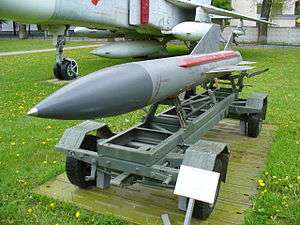Kh-58
The Kh-58 (Russian: Х-58; NATO:AS-11 'Kilter') is a Soviet anti-radiation missile with a range of 120 km. As of 2004 the Kh-58U variant was still the primary anti-radiation missile of Russia and its allies.[1] It is being superseded by the Kh-31. The NATO reporting name is "Kilter".
| Kh-58 (NATO reporting name: AS-11 'Kilter') | |
|---|---|
 Kh-58U in the Ukrainian Air Force Museum | |
| Type | air-launched anti-radiation missile |
| Place of origin | Soviet Union/Russia |
| Service history | |
| In service | 1982–present[1] |
| Used by | Russia, India, Algeria, Iran[1] |
| Wars | Russo-Georgian War Iran–Iraq War |
| Production history | |
| Designed | 1970s |
| Manufacturer | Raduga NPO |
| Specifications | |
| Mass | 650 kg (1,430 lb)[2] |
| Length | 480 cm (15 ft 9 in)[2] |
| Diameter | 38 cm (15.0 in)[2] |
| Warhead | High Explosive[1] |
| Warhead weight | 149 kg (328 lb)[2] |
| Engine | Solid rocket[1] |
| Wingspan | 117 cm (46.1 in)[2] |
Operational range | Kh-58: up to 120 km (65 nmi) Kh-58U :250 km (130 nmi)[1] Kh-58E: 46–200 km (25–110 nmi)[2] |
| Maximum speed | Mach 3.6 |
Guidance system | Inertial with passive radar seeker[1] |
Launch platform | Su-24M,[1] Mig-25BM,[1] Su-22M4,[2] Su-25TK,[2] Su-30MK[3] |
Development
The Bereznyak design bureau had developed the liquid-fuelled Kh-28 (AS-9 ‘Kyle’) and the KSR-5P (AS-6) anti-radiation missiles.[3] They merged with Raduga in 1967, so Raduga was given the contract in the early 1970s to develop a solid-fuel successor to the Kh-28 to equip the new Su-24M 'Fencer-D' attack aircraft.[3] Consequently, the project was initially designated the Kh-24, before becoming the Kh-58.
During the 1980s a longer-range variant was developed, the Kh-58U, with lock-on-after-launch capability. Since the fall of the Soviet Union, Raduga have offered several versions for export.[3]
Design
It was designed to be used in conjunction with the Su-24's L-086A "Fantasmagoria A" or L-086B "Fantasmagoria B" target acquisition system.[1] The range achieved depends heavily on the launch altitude, thus the original Kh-58 has a range of 36 km from low level, 120 km from 10,000 m (32,800 ft), and 160 km from 15,000 m (49,200 ft).[1]
Like other Soviet missiles of the time, the Kh-58 could be fitted with a range of seeker heads designed to target specific air defence radars such as MIM-14 Nike-Hercules or MIM-104 Patriot.[3]
Operational history
The Kh-58 was deployed in 1982 on the Su-24M 'Fencer D' in Soviet service.[1] The Kh-58U entered service in 1991 on the Su-24M and Mig-25BM 'Foxbat-F'.[1] The Kh-58E version can be carried on the Su-22M4 and Su-25TK as well,[2] while the Kh-58UshE appears to be intended for Chinese Su-30MKK's.[3]
Variants
_(524-20).jpg)
- Kh-58 (Izdeliye 112) - original version for the Su-24M.
- Kh-58U - improved version with longer range and lock-on-after-launch.
- Kh-58E - export version of Kh-58U[1], first offered in 1991.[3]
- Kh-58EM - another version offered for export in the 1990s.[3]
- Kh-58UShE (Uluchshennaya Shirokopolosnaya Exportnaya meaning 'Improved, Wideband, Export') - new wideband seeker in new radome, intended for Su-30MK.[3]
- Kh-58UShKE - version with folding fins for internal carriage in the Sukhoi Su-57, first unveiled at MAKS 2007.[4][5]
- Kh-58UShKE(TP) - version with added imaging infrared UV seeker, first unveiled at MAKS 2015.[6]
Some Western sources have referred to a Kh-58A that is either optimised for naval radars or has an active seeker head for use as an anti-shipping missile - it probably represents another name for the Kh-58U.
Operators

Current operators
- Iranian Air Force
- Malaysian Air Force
Former operators
See also
- Martel missile - Anglo-French collaboration with 60 km range
- AGM-88 HARM - Current US Air Force anti-radar weapon, range of 150 km
References
- Staff of Journal of Electronic Defense (2004), International Electronic Countermeasures Handbook, Artech House, pp. 149–150, ISBN 9781580538985
- X-58E, Tactical Missiles Corporation JSC, 2004, archived from the original on 28 September 2007, retrieved 10 February 2009
- "Kh-58 (AS-11 'Kilter')", Jane's Air-Launched Weapons, 24 October 2007
- "Airshow China 2014: PAK-FA's new anti-radiation missile set for 2015 series production", Jane's Defence Weekly, 13 November 2014
- "Kh-58UShKE Anti-Radiation Missile". Rosoboronexport.
- MAKS 2015: KRTV adds IR seeker to Kh-58UShK anti-radiation missile
- "Ukraine - Air Force Equipment". GlobalSecurity.org. 2014. Retrieved 23 July 2014.
Further reading
- Gordon, Yefim (2004), Soviet/Russian Aircraft Weapons Since World War Two, Hinckley, England: Midland Publishing, ISBN 1-85780-188-1
External links
- Tuomas Närväinen's Homepage - useful details